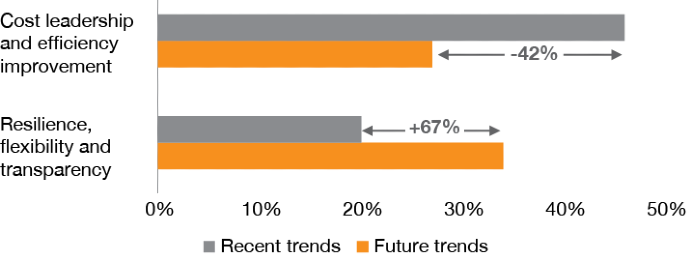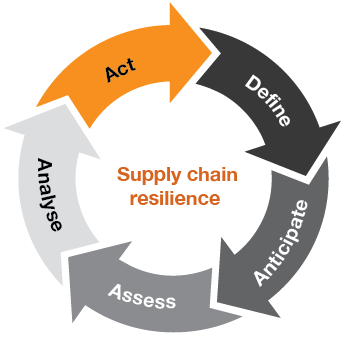Download the article
How do you build resilient supply chains that can weather multiple disruptions and unknown risks while balancing customer service and efficiency? Why is it important to build redundancies without significantly impacting costs and service levels across the supply chain? Sudipta Ghosh and Nitin Soundale provide some answers.
Increased globalisation, complex sourcing needs and diverse product portfolios have enhanced the complexity of supply chains across the world. These factors have exposed supply chains to multiple risks and disruptions, such as trade disputes, health crisis, geopolitical issues, environmental problems, demand volatility, supply shocks and regulatory changes. While efficiency remains the primary focus of supply chain executives, disruptions have prompted a strategic focus on resilience.
Resilient supply chains enable sustainable operations and uninterrupted service to customers. Such supply chains can weather multiple known and unknown risks and have both the agility and ability to recover from disruptions emerging from various sources. Therefore, resilient supply chains empower organisations to deliver continuous and consistent outcomes, resulting in increased trust among customers and other stakeholders across the value chain.
PwC’s Digital Factory Transformation Survey 2022 revealed a 67% increase in the number of leaders who believe that building resilience and flexibility is a key driver of supply chain transformation[1].
Top two priorities for supply chain transformation

Source: PwC Digital Factory Transformation Survey 2022
Megatrends such as climate change, a fracturing world, demographic shifts, social instability and technological changes are causing four types of disruptions from a supply chain perspective.
Supplier disruptions:
Supply disruption due to breakdowns, workforce issues, poor financial health of the supplier, inability to source raw material due to trade barriers, geopolitical conflict or overall commodity-level shortage (e.g. semiconductors), and regulatory and compliance-related issues can impact supply chain performance.
Logistic disruptions: Logistic delays due to demand–capacity mismatch (container shortages), port congestion, shipping lane blockages (e.g. the Suez Canal blockage), transport union strikes, regulatory changes and customs clearance delays, and force majeure issues can impact the seamless flow of inbound and outbound goods/materials across the supply chain.
Production disruptions: In-house manufacturing may get impacted due to machine breakdown and factory accidents leading to closures and workforce issues, thereby causing disruptions in the supply chain.
Demand disruptions: Unexpected fluctuations in demand occur due to multiple factors such as competition, new product launches, cannibalisation by new products and changing customer preferences.
Thus, proactive identification of applicable risks, accurate assessment of the impacts of various disruptions and prioritisation of response are required to build a resilient supply chain.
Our approach to building resilient supply chains is to create a digital replica that can be used to simulate various scenarios for accurate impact assessment based on quantifiable metrics such as value at risk and time to impact (TTI). This helps in identifying the points of failure within the supply chain and analysing the root causes for the same. It is then possible to devise strategic mitigation options – such as integrating an alternative supplier for key raw materials and maintaining a buffer inventory at important nodes. Sensitivity analysis may also be performed to understand the chokepoints of the supply chain for building redundancies without significantly impacting the cost across the supply chain.

PwC recommends a five-step approach for optimally improving the resilience of the overall supply chain using the example of a global manufacturer.
The diagram below represents the supply chain of a global manufacturer.

- Step 1: Define
- Step 2: Anticipate
- Step 3: Assess
- Step 4: Analyse
- Step 5: Act
Step 1: Define
Understanding and finding opportunities in as-is supply chains
The current state of supply chains can be segmented and simulated to identify the key reasons behind their vulnerabilities and chokepoints. A digital replica of an end-to-end supply chain can be created using advanced data analytics technologies to simulate different supply chain scenarios. The same replica can also simulate the impact of the stochasticity of various policy parameters (such as lead time, safety stocks and reorder policy) on the target key performance indicators (KPIs) like service levels and value at risk.
Example: A global manufacturer was facing challenges in managing inventories of its finished products due to regular disruptions and a complex multi-level supply chain structure. This led to large deviations from the acceptable target ranges for its key KPIs – service levels and contribution margin. To fix this, supply chain segmentation and simulations using a digital replica of its global supply chain were performed to understand the as-is supply chain better.
Finished goods (FG) inventory positions during as-is operations (without any disruptions): It is evident that digital replicas can help provide better insights into the working of supply chains. The following chart shows the day-wise simulated FG inventory positions at a distribution centre during normal operations.
Step 2: Anticipate
Identification of potential risks and disruptions
Early warning indicators can be designed based on market intelligence or predictive modelling to proactively identify potential risks and disruptions in the future. Inputs from key stakeholders can then be aligned with the list of potential risks. Artificial intelligence (AI) techniques, such as natural language processing (NLP), can assist in scanning a comprehensive dataset comprising both publicly available and subscribed datasets to generate early warning indicators and direct them as triggers to specified stakeholders.
Example: The supply chain of a global manufacturer was susceptible to multiple natural disasters due to geographical proximity of its processing plants and raw material suppliers to disruption areas. The disruptions were predicted based on historical data and external factors such as weather forecast data to identify potential risks to the supply chain.

Step 3: Assess
Impact assessment of the identified risks
Digital replica simulations can assess the impact of various combinations of disruptions on the supply chain nodes and also quantify their impact in terms of the relevant metrics. Such simulations will help to identify either the failure/chokepoints, or the opportunities for strategic decision-making.
Example: The overall supply chain of a global manufacturer was simulated across all identified disruption scenarios to quantify the potential drop in service levels and contribution margin. Based on the generated results, the key finished goods stockouts were also identified.
FG inventory positions with supplier disruption: The digital replica of a supply chain can help identify the TTI on FG inventory due to the unavailability of a raw material (RM). In the following case, the RM becomes unavailable on day 0, whereas the stockout of the respective FG occurs on day 100. Thus, the TTI is 100 days in this scenario.
Step 4: Analyse
Sensitivity analysis for identification of key parameters
Sensitivity analysis is performed on a supply chain on the basis of the synthetic data generated by the simulations to identify the most important parameters of the supply chain according to their impact on the key target metrics (e.g. customer service levels). The key parameters identified during this stage allow one to generate a prioritised path for designing recovery strategies.
Example: A global manufacturer performed the sensitivity analysis on a wider set of supply chain parameters and identified the production capacities and inventory replenishment policies that were critical for addressing the service-level disruptions. These were then used as the input for making additional investments to strengthen resilience without significantly impacting the overall cost of running the supply chain.

Step 5: Act
Planning and adoption of recovery strategies
Proactive mitigation strategies are designed to protect the key failure nodes and ensure potential improvements for each vulnerable part of the supply chain.
Changes in the supply chain need to be fed back to the simulation model to continuously monitor the future impact and course-correct where needed on an ongoing basis.
Intervention areas can be prioritised on the basis of the business impact and ease of implementation.
Business impact could be assessed in terms of:
- reduction in TTI
- Improvement in time to recovery
- increase in service levels
- optimisation of inventory costs.
Ease of implementation could be assessed by:
- the degree of complexity
- data availability
- internal change management
- availability of existing tools and technologies.
Example: To mitigate the impact of disruption, inventory policies were improved at a few warehouses, and buffer inventory was maintained to ensure the continuity of the supply chain.
Institutionalising such learning will help organisations become future ready.
Building resilience as a way of life
With increasingly globalised supply chains, building resilience is more of a necessity than a nice-to-have capability. Often, companies are faced with three key questions:
- where to begin?
- what are the most suitable solutions to build organisational resilience?
- who should own such an initiative?
The answers to these questions would differ based on the maturity of the current supply chain capabilities and specific situation(s) one is likely to face and would depend on the extent of exposure to relevant potential disruptions.
Evaluating as-is supply chains for potential vulnerabilities, identifying potential solutions, and laying out a clear roadmap to achieve resilience in a measurable and sustainable way can help companies chart this course successfully. These initiatives need to be sponsored by the CEO and championed by the supply chain teams, with support from the CDO/CIO. Finally, and most importantly, building and managing resilience should be a way of life for supply chain executives rather than a one-time activity.
Author introductions:
Sudipta Ghosh, Partner and Data and Analytics Leader, Industrial Products Leader
Nitin Soundale, Partner, Supply Chain and Operations
Also contributing to this article were Amit Pathak and Monjit Sikdar













